Planning for transitioning stock onto winter feed crops is of great importance in both preventing animal health issues and achieving intakes for maximum production.
The goal, when transitioning stock onto a crop, is to give the rumen environment time to adjust to the new feed and prevent the development of problems such as acidosis on fodder beet or nitrate poisoning on brassicas.
Accurate measurements of crop yield and dry matter are very important, especially of the portion to be used during transition, as this will allow correct break sizes to be calculated. This measurement should be taken just before the transition period starts, as the crop is probably still growing at this stage and a prolonged interval between measurement and feeding can lead to a discrepancy in feed allocation.
It is generally recommended that stock is introduced to the new crop gradually over 14-21 days, during which time the amount of pasture/supplement fed is decreased, and the amount of crop fed is increased. For fodder beet, mature cows should be started at 1-2kgDM/cow/day and increased by 1kgDM every second day. Heifers and yearlings should be started at 1kgDM/cow/ day, and only increased by 0.5kgDM every second or third day. Fodder beet should make up no more than 70% of the diet, and the remaining 30% should be supplemented with high fibre feed such as cereal straw. This should be given before animals are put onto the crop – never put hungry cows onto a break. Hungry animals are at the greatest risk of overeating and suffering from acidosis, so stock should be well fed with high fibre supplement both during and after the transition period. It is important to ensure that all cows have enough space at the face of the break to access the crop at the same time; this allows all animals equal access and should help to prevent more dominant animals from overeating.
Good electric fencing of each break is a must, and double hot wires can be used for extra security in preventing stock from breaking out and overeating.
Ensure that stock are not leaving behind large amounts of residual feed, as this can inadvertently result in overeating when additional breaks are given. During the transition period animals should be checked frequently and removed from the crop if showing any signs of illness. It is highly recommended that you observe animals as the new break is opened, but also that you check on them an hour later. This helps to identify animals which have initially started eating the new break but have then removed themselves.
Do not feed any crops that are frosted – wait until it has lifted. Stock fed on frosted crops such as kale are at higher risk of developing bloat, and nitrate levels that build up in plant leaves during poor weather may rise high enough to cause toxicity. There is some evidence that in heavy frosts the frozen fodder beet bulb can cause damage to the incisors of grazing stock, particularly in younger animals.
When transitioning onto most forage crops there is a risk of things going wrong, from acidosis to nitrate poisoning to bloat. For individualised advice about transitioning your stock on your property, please get in touch with your local Vetlife clinic.
For further information on transitioning stock to winter crops on your farm, or for any animal health concerns, contact your local Vetlife veterinarian.
Ben Finlayson
Vetlife Oxford
